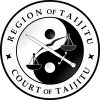Template:This month's featured article/September, 2010
The Court of Taijitu is the sole judicial body of Taijitu. It is composed of three members, a chief justice who administers the Court's business and two associate justices who rule on cases alongside the chief justice. Currently only the office of chief justice is occupied. All justices are appointed through nomination by the delegate and subsequent confirmation by the Senate. They serve until retirement or until removed by the Senate. The Court tries all criminal and civil cases under Taijituan jurisdiction, and arbitrates disputes between Taijituan citizens. The Court is also explicitly granted the power of judicial review by the Constitution of Taijitu, and may strike down government acts or laws which it deems to be unlawful or unconstitutional.
The history of Taijitu's judicial system is not as storied as that of the other two branches of government. Its powers have remained effectively unchanged, while its structure has only varied slightly. The first judicial body of Taijitu under the region's original constitution was the Supreme Court. There was no constitutionally mandated distinction between associate justices and and a chief justice responsible for administering the court, and the maximum number of justices was limited to nine. It was given the general power to try any cases brought before it without specifying the nature of these cases.
In June of 2010, a new constitution was drafted as part of a regional revival. The judiciary's name was changed for a second time to simply the Court of Taijitu, and any constitutional limitations on the size of the Court were removed, replaced instead by a default number that could be altered by law. The then single office of justice was split into the offices of associate justice and chief justice, the second of which was charged with administering the Court's business. The Court's power to try both civil and criminal cases and arbitrate disputes was made explicit instead of merely implied in its general ability to try cases, and the responsibility of administering elections and referendums was also placed upon the Court. Previously elections had been administered by either the delegate or speaker of the Senate as provided by election laws.
The appointment of justices is a two step process. The delegate must first nominate a candidate. Nominees must then be confirmed by a two-thirds majority vote of the Senate before they can become a justice. Though not constitutionally required, votes on whether to confirm a nominee for justice have always been preceded by some manner of formal review. Once in office, justices may serve indefinitely until their resignation or forced removal from office. The latter of these two options may be brought about by a two-thirds majority vote of the Senate. As unelected officials, justices may not be recalled like the delegate and senators.
